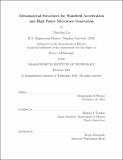Metamaterial structures for Wakefield acceleration and high power microwave generation
Author(s)
Lu, Xueying,Ph. D.Massachusetts Institute of Technology.
Download1132723522-MIT.pdf (5.650Mb)
Other Contributors
Massachusetts Institute of Technology. Department of Physics.
Advisor
Richard J. Temkin.
Terms of use
Metadata
Show full item recordAbstract
This thesis presents the theoretical and experimental investigation of the interaction of metamaterial structures with electron beams for two applications: wakefield acceleration and high power microwave generation. Under the topic of wakefield acceleration, on the theoretical side, several metamaterial structures have been designed and simulated. The novel phenomenon of reversed Cherenkov radiation has been found to enhance the beam-wave interaction in metamaterials. A metallic wagon wheel metamaterial structure was designed and built for use in an experiment at the Argonne Wakefield Accelerator (AWA) Facility. On the experimental side, this thesis presents the first demonstration of high-power, reversed Cherenkov wakefield radiation by short electron bunches passing through the wagon wheel structure at the AWA. Single 45 nC electron bunches of 65 MeV energy traversing the structure generated up to 25 MW in 2 ns pulses at 11.4 GHz, in excellent agreement with theory. Two bunches of 85 nC with appropriate temporal spacing generated up to 80 MW by coherent wakefield superposition. If this power were applied to a trailing witness bunch in a collinear wakefield accelerator, it would provide an accelerating gradient of 75 MV/m. Under the topic of high power microwave generation, on the theoretical side, an analytical theory has been developed to predict the novel Cherenkov-cyclotron interaction in metamaterial-based microwave devices. An S-band metamaterial-loaded waveguide with reverse symmetry has been designed and built to work with the Cherenkov-cyclotron interaction. On the experimental side, this thesis presents the experimental results of the metamaterial-loaded waveguide built at MIT. Power levels to 2.9 MW at 2.4 GHz in full 1 [mu]s pulses were generated by an electron beam of up to 490 kV of voltage and 84 A of current. Frequency tuning measurements verified that pulses above 1 MW of output power were only seen in the Cherenkov-cyclotron mode. With these results, this thesis demonstrates the unique features of metamaterial structures that are very attractive for high-gradient wakefield accelerators and high power microwave sources. Advantages include the high shunt impedance for intense beam-wave interaction; the simple and rugged structure; and a large parameter space for various optimization goals
Description
This electronic version was submitted by the student author. The certified thesis is available in the Institute Archives and Special Collections. Thesis: Ph. D., Massachusetts Institute of Technology, Department of Physics, 2019 Cataloged from student-submitted PDF version of thesis. Includes bibliographical references (pages 209-218).
Date issued
2019Department
Massachusetts Institute of Technology. Department of PhysicsPublisher
Massachusetts Institute of Technology
Keywords
Physics.